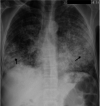Pulmonary Tuberculosis Presenting As Septic Shock in an Immunocompetent Patient: Revisiting an Old Disease With New Perspectives
- PMID: 37182005
- PMCID: PMC10170580
- DOI: 10.7759/cureus.37362
Pulmonary Tuberculosis Presenting As Septic Shock in an Immunocompetent Patient: Revisiting an Old Disease With New Perspectives
Abstract
Septic shock due to Mycobacterium tuberculosis (M. tuberculosis) in immunocompromised patients (particularly HIV) is a well-recognized clinical entity. However, tubercular sepsis in the immunocompetent is still underdiagnosed and under-discussed. Moreover, sepsis is usually associated with gram-negative and other gram-positive microorganisms that can cause similar pulmonary and disseminated disease and can further convolute the diagnosis. We herein discuss a case of an elderly female who presented with acute onset fever, cough, and altered talk from the last seven days. Her initial clinical and laboratory examination revealed features of lower respiratory tract infection with septic shock. She was started on broad-spectrum antibiotics based on severe community-acquired pneumonia management guidelines. Her blood and urine cultures were sterile. She did not respond to initial antibiotics. Furthermore, sputum production was not possible, which compelled us for gastric aspirate analysis, which came positive for cartridge-based nucleic acid amplification test (CBNAAT). In repeated blood cultures, M. tuberculosis was also isolated. She was started on antitubercular treatment; on the 12th day of antitubercular treatment, she developed acute respiratory distress and eventually succumbed to her illness on the 19th day of hospitalization. We highlighted the importance of early diagnosis and prompt antitubercular therapy in tubercular septic shock. We also discuss the possibility of tubercular-immune reconstitution inflammatory syndrome (IRIS) in such patients, which could be a contributing factor to mortality.
Keywords: immunocompetent; pulmonary; sepsis; septic shock; tuberculosis.
Copyright © 2023, Malik et al.
Conflict of interest statement
The authors have declared that no competing interests exist.
Figures


Similar articles
-
Tuberculosis septic shock, an elusive pathophysiology and hurdles in management: A case report and review of literature.World J Crit Care Med. 2019 Sep 11;8(5):72-81. doi: 10.5492/wjccm.v8.i5.72. eCollection 2019 Sep 11. World J Crit Care Med. 2019. PMID: 31559146 Free PMC article.
-
Pulmonary tuberculosis in HIV-infected patients with normal chest radiographs.AIDS. 1992 Jan;6(1):91-3. doi: 10.1097/00002030-199201000-00012. AIDS. 1992. PMID: 1543571
-
[Early manifestation of septic shock and disseminated intravascular coagulation complicated by acute myocardial infarction in a patient suspected of having Legionnaires' disease].Kansenshogaku Zasshi. 1998 Mar;72(3):286-92. doi: 10.11150/kansenshogakuzasshi1970.72.286. Kansenshogaku Zasshi. 1998. PMID: 9585703 Japanese.
-
Surviving sepsis campaign: international guidelines for management of severe sepsis and septic shock: 2012.Crit Care Med. 2013 Feb;41(2):580-637. doi: 10.1097/CCM.0b013e31827e83af. Crit Care Med. 2013. PMID: 23353941
-
Disseminated Tuberculosis Associated Hemophagocytic Lymphohistiocytosis in a Pregnant Woman With Evans syndrome: A Case Report and Literature Review.Front Immunol. 2021 Jun 10;12:676132. doi: 10.3389/fimmu.2021.676132. eCollection 2021. Front Immunol. 2021. PMID: 34177917 Free PMC article. Review.
References
-
- Mycobacterium tuberculosis septic shock. Kethireddy S, Light RB, Mirzanejad Y, et al. Chest. 2013;144:474–482. - PubMed
-
- Mortality related to severe sepsis and septic shock among critically ill patients in Australia and New Zealand, 2000-2012. Kaukonen KM, Bailey M, Suzuki S, Pilcher D, Bellomo R. JAMA. 2014;311:1308–1316. - PubMed
Publication types
LinkOut - more resources
Full Text Sources
Research Materials
